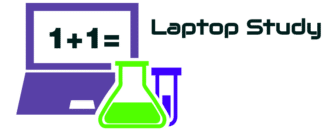5 Best Laptops For Data Science (ML , DL & AI Libraries) 2024
If you know the size of your typical dataset and the type of data analysis you do, finding the best laptop for data science for you is pretty straightforward. Let’s say…
A) If you work with R & Pandas to run data sets that can fit in RAM memory (4GB-16GB)to run non-deep learning models. Any modern laptop that can have RAM upgraded to 16GB RAM will do. Most data scientists fall in this category!
You can speed up the process by choosing the fastest CPU (the Apple Silicon CPU chips are the fastest as of 2024).
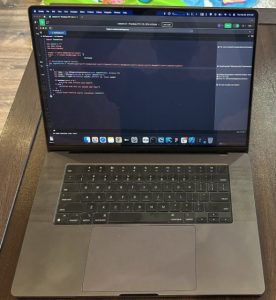
B) If you work with parallel processing libraries (which make use of GPU cores) such as deep learning. You want a laptop with 6GB vRAM for NLP (text data) and as much vRAM as possible for CV (image) data. The best choice here would be a desktop with a mid to high-tier GPU though.

C) Optionally, you can use computer clusters (see featured image) to process any data (deep learning, neural networks, machine learning, etc) regardless of size and complexity. They can process data hundreds of times faster than any computer. To connect/use these clusters you need a subscription and ANY laptop.
Best Laptop Specs for Data Analysis
“With greater data sets comes greater insights”.
The bigger the data set the bigger the RAM memory needed.
RAM’s the #1 most important factor for data science. Followed by CPU & GPU cores.
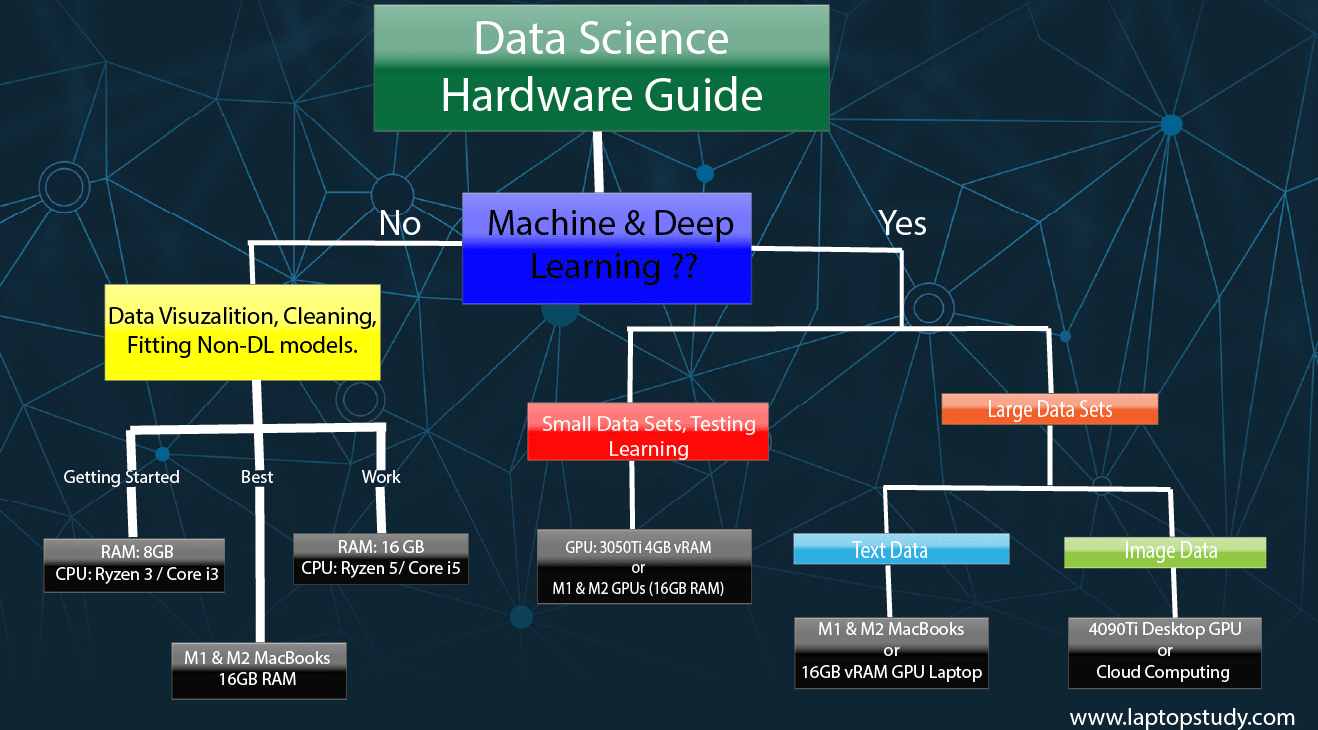
RAM
RAM is thefirst bottleneck as data size grows. If you have 2x the RAM of a data set size (8GB RAM vs 4GB data), things speed up an order of magnitude because all your processing is in-memory (RAM).
16GB RAM: bare minimum. Not common on non-gaming laptops but most laptops can have their RAM upgraded (usually up to 32GB for budget laptops and 64GB for gaming rigs).
CPU
Faster CPUs are always good. However most CPUs are way too fast, RAM will become the main bottleneck long before CPU comes into play.
For example: if a CPU can process 10**5 pieces of data sets per second and if 32GB RAM can only serve 10**4 pieces of data per second, what’s the point of buying a faster CPU?
Assuming you have maxed out on RAM memory, then you can worry about CPU:
If working with R & Python, choose the CPU with the highest clock speed (algorithms are mostly single-threaded).
The fastest CPU for most CPU intensive algorithms and libraries is the M3 Max. However, the previous Apple Silicon Chips like the M1 & M2 chip will beat Intel too.
GPU
NVIDIA CUDA: If you WANT to work with deep neural networks or parallel.NN (parallell computing) algorithms for IMAGE PROCESSING then get:
- NVIDIA GPU lots of vRAM & lots of shaders ‘CUDA cores’. On laptops the fastest GPU is the 4090RTX.
If you can’t get a dedicated GPU don’t sweat it. Most data scientists use cloud services for these kind of processing and you should learn how to too.
SSD
Storage speed (SSD Type) has little impact, if any, on the data crunching process but if you want to maximize speed when transfering files from drive to drive: the fastest is PCIe NVMe 5.0 but that’s not yet available on laptops.
Keyboard
Good keyboards on laptops are not easy to find and usually expensive. If you don’t feel comfortable with the built-in keyboards no worries, just get an external keyboard. External mouse or ball trackpad is a MUST, you dont want RSI and tendonitis.
Display
Min FHD 15” screen: Chances are you’ll be either ssh’ing into a more powerful machine or using the cloud at some point thus you want extra screen space to see longer pieces of commands at a time. The higher the resolution, the higher the gains in screen area.
OSX
Mac vs. Windows vs. Linux – the best OS for data science is either a Linux-based machine or an OSX apple computer. But that doesn’t mean you should limit your choices to MacBooks or windows laptops that are compatible with Linux. You can always run Linux as a virtual machine.
Top 6 Best Laptops for Data Science
In this list I’ve tried to include a laptop for EVERYONE: beginners, students and Data Scientists (those into parallel programming, machine learning, deep learning and those Using AWS/Cloud Services,etc.)
Just read the descriptions carefully and you’ll be sure to find your best pick.
1. Acer Nitro 5
Best Budget Laptop for Data Science
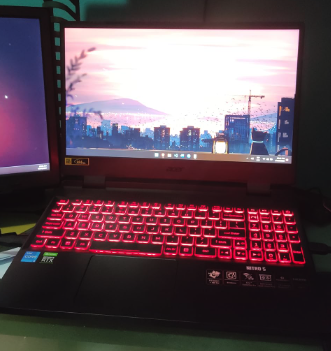
Core i5 12500H
16GB DDR4
3050Ti RTX
512GB PCIe NVMe SSD
15.6” 60Hz Full HD IPS
5.51 lbs
5 hours
Best for All types of Data Science (ML & AI)
This laptop has every spec you need to get started in pretty much every branch of data science.
It has 16GB RAM out of the box to run large data sets and a GPU for machine learning algorithms or any algorithm that makes use of GPU parallel processing.
Why the Acer Nitro 5?
There are MANY laptops with a 3050RTX but two reasons that make this one stand out from the rest:
- RAM is upgradeable all the way to 64GB RAM.
- It has a 3050Ti as opposed to a regular 3050RTX, this makes a big difference as you’ll see later.
RAM: 8GB RAM (Up to 64GB)
We established that 8GB is enough for simple statistical, ML/DL models of small data sets and any data analysis package and software (R/MatLab/SAS,etc).
Now what is a small data set?
For text/numerical data would be 300k rows with 4 variables each.
This should take around 300MB.
Now…Windows 12 will take 4GB (depending on the total RAM).
Background programs + IDE : 1GB.
If you have 8GB RAM, you’re left with 3GB RAM. This means you can run data sets x10 times as big. Thus with 8GB RAM, you can run data sets up to 3GB.
In numerical/text format it would look like:
3G/300MB~10*300k rows=3000K rows with 4 variables.
If you’re getting started with data science, it is very unlikely you’ll work with a dataset this big. If you do encounter datasets much bigger (10GB), then you can use the cloud.
Q: What if I don’t want to use the cloud and run bigger data sets?
This is why it’s important to make sure your laptop’s RAM is upgradeable to at least 32GB RAM.
This laptop has no RAM soldered (unreplaceable), it has TWO slots both can be replaced. Thus you can buy x2 16GB sticks to make it 32GB or even x2 32GB RAM sticks to make it 64GB!
Assuming you upgrade RAM to 64GB RAM, you can run:
3000K*20=60 000K rows = 60 MILLION ROWS with 4 variables each on this laptop.
Do you think you’ll run data sets bigger than that? Exactly…if you do then the problem is not going to be lack of memory but rather lack of CPU power and this is why you have to use the cloud for data sets that big. Sooner or later, you will.
Data sets this big for CPU-based data crunching is rare!
GPU: 3050Ti Parallel Processing
Everybody knows deep learning and machine learning algorithms run much faster with more cores and most libraries do not use CPU cores but rather GPU cores.
If you have a budget under 800 dollars and want to run deep learning/ML data sets that make use of GPU cores, take a look at the available GPUs under 800:
| GPU | CUDA Cores |
| MX 350 | 640 |
| MX 450 | 896 |
| 1050 | 640 |
| 1050 Ti | 768 |
| 1650 | 1024 |
| 2050RTX | 2048 |
| 1060 | 1280 |
| 1660 Ti | 1536 |
| 3050RTX | 2048 |
| 3050Ti | 2560 |
| 2060 | 1920 |
The 3050Ti has way more CUDA ‘Cores’ than the rest of the GPUs and this will increase computing performance for ML , AI & DL data sets by about 1.5x.
Of course, that’s assuming the data sets you use can fit in video RAM which is 4GB (the GPU cannot process data out of the regular ‘RAM’). This is mostly for testing/learning purposes. Real life DL & ML data sets are much bigger and will most of the time require the use of computer farms.
| Acer Nitro 5 | |
| PROS | CONS |
|
|
2. M3 MacBook Pro
Fastest Laptop For Data Analysis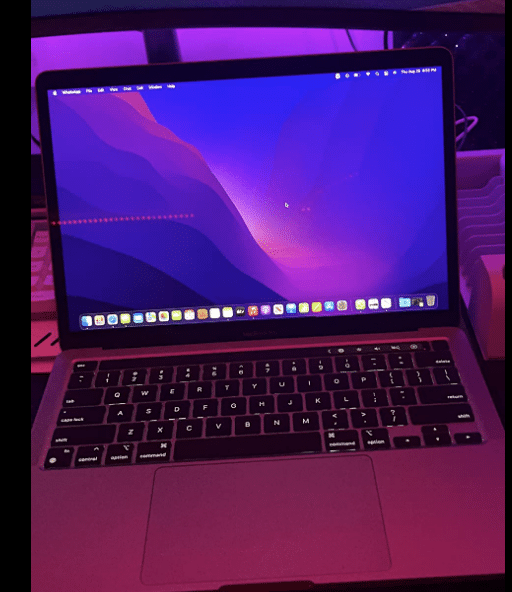
M2 Pro Chip 10 core (Up to 12)
24GB Unified Memory (Up to 96)
10 core GPU (Up to 19)
512GB-2TB PCIe SSD
13” Retina (Up to 16”)
3lbs (5lbs)
18 hours
Best for All types of Data Science (ML & AI & Neural Networks)
Without a doubt the best laptop for data science as of 2024.
All the Apple Silicon Chips (M1, M2 & M3) have been ‘optimized’ for machine learning, deep learning and neural networks. They are MUCH faster than ANY intel or amd CPU on laptops. Why?
-
For deep learning, machine learning, neural networks the Apple Silicon Chips outperform Intel/AMD CPUs even Core i9/Ryzen 9 CPUs.
- The reason is not because they have higher clock speeds but because they have much more efficient “RAM”. In other words, RAM on these MacBooks can feed the CPU at a much faster rate. RAM is called ‘unified’ because the GPU also have EASY and FAST access to it. There is no “vRAM” on the M3 MacBook.
- So having 16GB or 64GB “RAM” on a MacBook means both the GPU & CPU will have complete and “FASTER” access.
- The M3 Chips and the previous chips have WAY more cores than Intel/AMD CPUs on laptops.
- Lastly, the architecture itself has been optimized for “machine learning”.
Now….
- Not ALL libraries are compatible with the M1 & M2 & M3 Chips. However, as of 2024, more and more libraries are being written for compatibility with the M1, M2 & M3 Chips. Before you purchase however you may want to check whether a specific library runs on Apple Chips , if not, be sure to find alternatives that do.
NVIDIA GPUs vs Apple Silicon Chips Benchmarks
Benchmarks with TensorFlow PyTorch (Deep Learning) show that the Apple Silicon chips are much faster than the NVIDIA GPUs found on laptops. This is due to the lack of memory of GPUs found on windows laptops (NVIDIA’s 4090Ti is limited to 16GB vRAM) where as the M3 Chips supports up to 36GB Unified memory.
On the other hand, if the benchmarks are carried out with the same amount of “MEMORY”, the NVIDIA GPUs beat the Apple Silicon Chips. This is due to the superior “GPU processing” power of CUDA Cores which are much more numerous.
More reasons to pick a MacBook:
Given the advantages for these libraries, there are other good reasons to use a MacBook for data science purposes:
-
The UNIX-like environment. OSX is the most work-efficient OS for data science along with Linux.
- It isn’t just about Python but also the software packages and programming languages readily available out of the box AND how easy/useful is the terminal.
-
Unrivaled battery life & portability.
- Imagine having to ssh into a cloud service to do the processing. You can check the process and progress through a MacBook even if you’re away from outlets for more than 15 hours. You can also upload chunks of data/fix/re-run the algorithm on the go.
- High resolution display (retina): massively increases the amount of screen space. Super useful to get a bigger picture of your data and to find bugs on your scripts.
MacBook Air or MacBook Pro?
If you’re only using this laptop for Data Science only: grab the M1, M2 or M3 MacBook Air. It’s as equally useful for Data science as the M3 MacBook Pro. If you’re also going to use this for other heavy software (3D modeling, gaming, video editing, etc) then grab the MacBook Pro..
| M3 MacBook Pro | |
| PROS | CONS |
|
|
3. Lenovo ThinkPad P1 Gen 6
Best Windows Laptop for Data Analysis
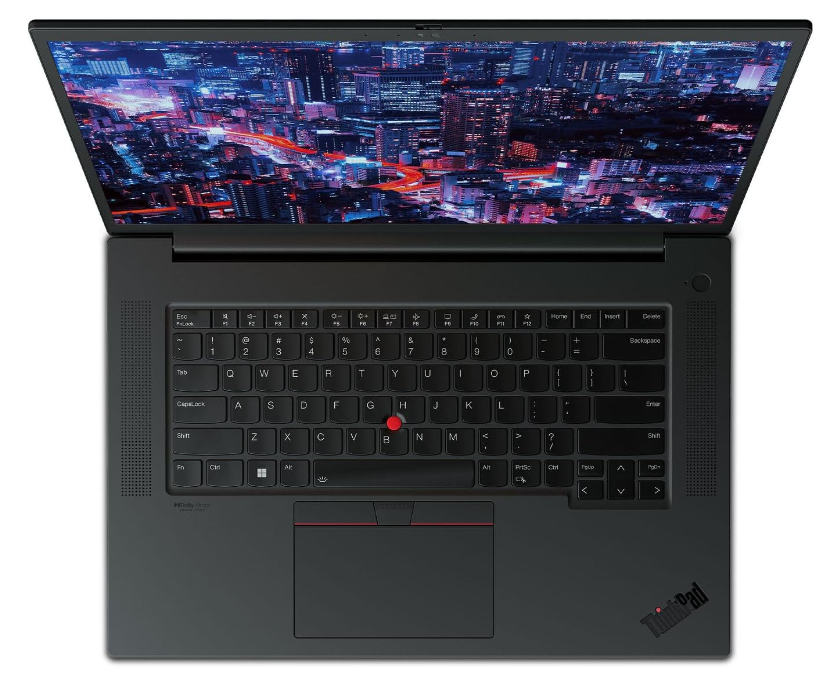
Core i7-13800H
32GB DRR5
RTX 4080 12GB vRAM
1TB SSD PCIe Gen4
16” QHD 165Hz IPS
3.92 lbs
6 hours
Best for All types of Data Science (ML & AI & Neural Networks)
Lenovo Thinkpads are one of the most popular laptops for Data Science for the simple reason that they’re the way to go if you want to have Linux natively installed. That is , running Linux with no virtual machines.
ThinkPads & Linux
Is it a requirement to use Linux?
No, windows works fine too. All statistics platforms like R, scikit-learn, or the many many others avaiable, are available in all three operating systems: OSX, Linux & Windows.
However Linux Distros (versions of Linux) just like OSX has easy to use and a better terminal.
Terminals make it super easy to connect to computer infrastructures. Windows has also implemented a terminal but the OSX & linux terminals are not only better but mainstream so you’ll easily find tutorials and guides for pretty much ANYTHING you want to do through the terminal.
More importantly most packages and algorithms are always written for UNIX systems.
Most data scientists will move on to Linux Systems at some point. Want to speed up your career in data science? Might as well get used to Linux from the get-go. OSX which is basically a variant of Linux so it’s a good alternative too.
Windows laptops also support Linux . You can install Linux natively however you will come across some features not being compatible (lack of drivers) when you use a windows laptop and switch to Linux. Though most laptops won’t have that issue, ThinkPads are one of the few laptops that assure you of 100% compatibility without having to resort to virtual machines!
RAM: 8GB-48GB DDR5
Thinkpads upport RAM anywhere from 8GB to 64GB RAM. The upper limit for most however is 48GB.
64GB RAM Thinkpads can be found on the official website. There are some thinkpads that can support 128GB but those are workstation laptops which cost a LOT of money (Approx 3000+).
The laptop I’m featuring here supports 64GB RAM.
DDR5 vs DDR4
Just like there are CPU generations, there are RAM generations. The latest the generation the faster the RAM. That means if you have two equally sized RAM sticks, the latest will be faster.
For data science purposes this is super important especially for CPU-dependent algorithms since RAM is the memory that feeds data for the CPU to process.
The Acer Nitro 5 (first laptop) supports RAM up to 64GB RAM but it’s limited to DDR4, it does not support DDR5. However, the thinkpad here and most thinkpads (as long they’re the latest) will support DDR5 RAM.
For most purposes, the difference in overall speed of your computer and small data sets will be insignificant. However, as data sets get bigger, the performance gains will be noticeable. If you work with very large data sets (say you use 60GB), there will be SIGNIFICANT gains.
DDR5 cannot be found on just about any laptop even if the laptop’s CPU is very recent. It’s a good way to pin-point those with the latest RAM but it isn’t a bullet proof method. However if said laptop does not automatically come with DDR5 then you can be sure it will not support an upgrade to DDR5 because it is down to the motherboard used by manufacturer (which dictacts the pin socket available, a pin socket only supports either DDR4 or DDR5).
GPU & CPU: RTX 4080 & Core i7 13700H
Most thinkpads are much cheaper than this laptop. The reason why this one is expensive is really only due to the dedicated graphics. Thus if you are not going to be running parallel processing algorithms like ML & DL but rather CPU-intensive algorithms, then you can buy any of the thinkPads without the dedicated graphics.
I know most readers here still want to run ML & DL algorithms on their laptop hence why I’m posting this laptop.
This year I’m posting a thinkpad with one of the two most powerful GPUs found on laptops….as opposed to those models with a 4GB vRAM GPU (3050 RTX).
The 4080 RTX has 3 times the vRAM ~12GB vRAM and x3 more CUDA cores:
| 3050Ti | 2560 | 4GB | 1485 |
| 4080 RTX | 7424 | 16GB | 2280 |
The difference? The 4080RTX is more likely to be useful for real world ML & DL since it can run data that’s BIGGER at a faster rate.
Although, I’d still recommend a Lenovo ThinkPad with no dedicated graphics because ultimately the cloud has to be used for ALL DL & ML data.
CPU: The CPU may be faster than the Apple Silicon chips at least on paper but because the MacBooks use UNIFIED memory, any CPU-based algorithm will run faster on the M1 & M2 MacBooks.
| Lenovo Thinkpad P1 Gen 6 | |
| PROS | CONS |
|
|
4. HP 14″ Laptop
Cheap Laptop For Data Science
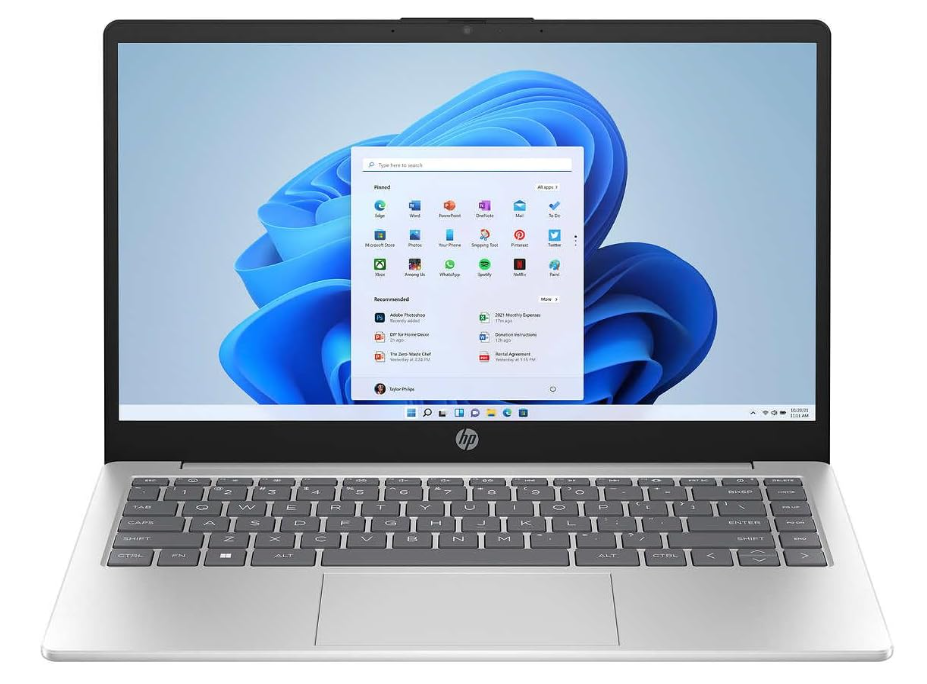
Core i3-1315U
8GB DDR4
Intel UHD Graphics
512GB PCIe® NVMe™
14” FHD IPS
3.3 lbs
7 hours
WiFi 6 802.11AX
Best for Basic Data Science & Learning
Although this is a basic laptop for data science, it’s still a good choice if you want to get started with Data Science while on a low budget. You can use it to ‘test’ the waters and see if Data Science is a career for you.
Or if you are willing to rely solely on the cloud, you can even use it to work with real world data and actual jobs.
RAM: 8GB (Up to 32GB)
Data Scientists outside of DL & ML do not work with large data sets so 8GB RAM is plenty for IDEs, programming, statistical models, output & present data visuzalition through Panda, etc.
When there’s a need to run parallel processing algorithms with large data sets (which require a tremendous amount of RAM to run faster) , just simply connect to a cloud service pay a few fractions of dollars and be done with it.
As for teaching yourself data science, you can do so with just 8GB RAM. Even the heaviest IDEs won’t require you to have more. You can also use 8GB RAM to test small data set samples for DL & ML again before uploading it to the cloud (usually you take a small batch, see the results in a graph, then upload the largest data set to the cloud, run it, see the results & compare).
CPU: isn’t the Core i3 too weak for Data Science?
While it’s on paper the weakest CPU out of the Intel Core family, it isn’t true that’s slow for data science purposes.
In fact, since it’s a 13th gen CPU. It may be a little overkill for programming, running algorithms and so on.
Remember the main bottleneck for data science it’s going to be RAM and for DL & ML : GPU cores.
The cool thing about this HP model is that you get the latest Core i3 under 400 dollars whereas in most cases you’ll get a 12th or even 11th gen Core i3 CPU.
I know I just said CPU is sort of irrelevant when you’re looking at a basic laptop for data science but it’s always nice to have the latest especially if you want to make multitasking faster (the more recent the CPU, the better the multi-core performance).
Having better multi-core CPU performance also means being able to run those CPU-dependent algorithm (that can have their data fit into 8-32GB RAM) FASTER. Though not much faster, still faster, for nearly the same price.
Portability & WiFi: 3lb + FHD resolution
As a bonus this laptop is somewhat portable too: 3.3 lbs isn’t that heavy, it’s actually 1/3 pount heavier than a MacBook Air or windows ultrabooks and despite the fact that it’s a 14” display !
14” with FHD resolution gives you a decent amount of screen space area to code without having to scroll down too much. Also decent for multitasking (having a SSH window – terminal + a tutorial/data rows).
Ideally, you’d want a QHD resolution to get you started with data science. QHD resolution displays will significantly add screen space area which is CRUCIAL when you get started since having more tutorials, videos & sample scripts on the same screen (without having to ALT+TAB) speeds up your workflow.
Unfortunately, laptops with QHD resolution are still expensive (600+ dollars), a good exampel is the Lenovo Idea 5i Pro.
| HP 14” Laptop | |
| PROS | CONS |
|
|
5. MSI Raider GE78HX
Best Laptop for Data Science – Parallel Processing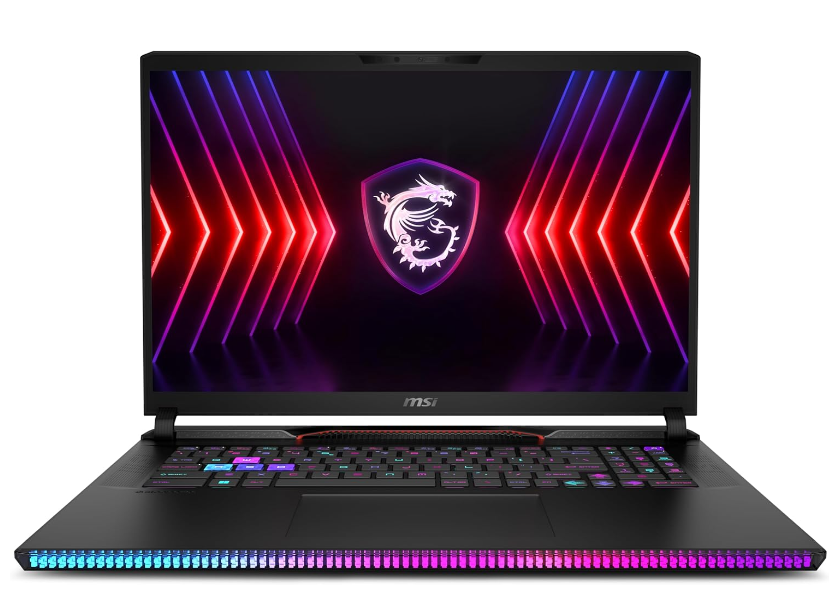
Intel Core i9-14900HX
64GB DDR5
NVIDIA Geforce RTX 4090 16GB vRAM
2TB NVMe SSD
17” 240Hz QHD+
6.61 lbs
1 hour
Best for ML, DL & Neural Networks
This laptop has as much hardware you’re going to get out of personal computers for data science. Everything here is maxed out: CPU, RAM, GPU, Storage. Although the latter is irrelevant if we are talking about fast data crunching it becomes useful if you want to download and upload extremely large sets of data.
Only gaming laptops & workstation laptops will have these kind of hardware specs.
CPU: Core i9 14900HX
The latest & most expensive workstation or gaming laptops will either have a Core i9 or Ryzen 9. For data science purposes, both can be said to be equally as fast although one of the two will have better multi-core performance (usually the ryzen 9) and the other one will have more clock speed performance (Core i9).
The advantage of going these two CPUs (as long as they’re from the 13th or 14th gen) is that they also support for DDR5 RAM. Since they’re usually found on high-end large gaming laptops or workstation, there’s support for 64GB or even 128GB.
128GB RAM laptops used to be limited to workstation laptops (which were selling for about 3000 or more) but now it’s very common to find 64GB on laptops under 1000 (Acer Nitro 5 is a good example, only 700 dollars yet supports 64GB) so it makes sense that gaming laptops (1000 dollars plus ) can support 128GB.
GPU: 4090 16GB vRAM (or 16GB)
The most powerful graphics card on laptops is a 4090RTX. It has the largest amount of vRAM and CUDA cores. The 4090RTX isn’t the only GPU with 16GB vRAM however.
If you’re going to work with a variety of applications in data science: image processing + deep learning.
16GB vRAM is a pretty good size to test and get meaningful deep/machine learning results with real-world data. Although much larger datasets (larger than 16GB) are used in real world applications.
| MSI Raider GE78HX | |
| PROS | CONS |
|
|
How To Choose the Best Laptop or Desktop Computer For Data Analysis & Data Science
What you’ll learn in this section is how to get as much computing power out of a desktop or laptop for data analysis.
This is going to help you maximize performance for a given budget.
Before we go over the hardware details, I’ll briefly talk about the software & how to do data analysis for newbies.
If you’re already acquianted with data analysis jump to the hardware section.
Two ways to do Data Analysis
A) Using the Cloud
You should learn how to use the cloud regardless of how you plan on doing data processing.
Cloud services use a cluster of computers to do all the processing orders of magnitude faster than any personal computer.
For example, Amazon Web Services gives access to on-demand EMR multi-machine clusters per hour including all of their data stores like ElasticSearch, Redshift, etc.
How to use a cloud service?
You just need a 4-8GB RAM laptop with an internet connection. You can ssh into a cloud service through a terminal:
Extra battery is more important here than any other spec if you want to work away from home.
It is not uncommon to ONLY use the cloud for data science .
People usually start with hadoop clusters before they use cloud services or computer farms.
Usually a small sample data is tested on a laptop then the full data set into these computer clusters.
B) Personal Computer
The most powerful personal computer for data analysis is going to be a desktop with:
- A high clock speed & multi core CPU (multi core AMD CPUs have better specs/money)
- 128GB of RAM.
- SSDs in a RAID set up.
- GPU with the highest vRAM & CUDA Cores available.
You can have somewhat of your personal server too, the cheapest ones will be older machines (nonetheless they are clusters so they’ll be faster than your average desktop). They can be found on:
- Amazon, Ebay or any other e-commerce site.
- Data science Facebook groups: some people will post their set ups for sale.
Software & Hardware Specs
Some workflows (software & algorithms) will find some specs more user than others .
A) Student
Data science students use a combination of the following software/languages:
- R
- Python
- SAS
- SPSS
- Stata
- Tableu
- MatLab
Most of these are just libraries, any laptop with 8GB RAM (or less if you use Linux) can run IDEs with any of the languages and libraries.
Plus there isn’t going to be any big data crunching and if there is, you will have free cloud services (or university computers you can SSH into).
Installing modules/extensions
The only struggle you’re going to have is having R, Python with all its packages installed on a laptop, it takes a WHILE to do the whole process error-free.
My first time doing the installation process took me a week, today you don’t have to spend a week (maybe a day at the most) there are plenty of tutorials and guides on how to do this fast and efficiently.
The whole process is much easier on Linux systems followed by MacBooks and Windows.
If you’re a student, I’d recommend OSX (Apple) to get you started.
They are the perfect balance between easy-to-install package ecosystem and easy-to-use OS.
Price should not be an issue because refurbished older models behave like new and the hardware is still plenty fast for programming.
B) Data Scientist
You will use any of the software/programming languages outlined above plus a combination of the following:
Once you add Hadoop to your arsenal that means you’re going to run data sets in the GBs range and this is where hardware specs become crucial.
I’m sure you’ve read about the three types of problems in data science: volume, velocity or variety.
Well, Hadoop is a volume & velocity problem and this is why most people use a cloud service.
This post is about laptops so it assumes your datasets are relatively small (less than 20 gigabytes for images and less than 64GB for text).
A small data set can said to be “anything that can fit in RAM memory” . If you have a data set larger than 50-100GB, that you mayhave to use distributed computing even for simple calculations.
Most data scientists (especially those getting started ) deal with “variety problems” . In this case data sets are small thus laptops or desktop with 16-32GB RAM and/or 4GB-8GB vRAM GPUs (for deep learning & machine learning samples) are OKAY.
Machine & Deep Learning
In the case of ML, more data means better results. More data means you’ll need more RAM and vRAM.
Say if you have a 16GB data set to train then IDEALLY you want a 16GB RAM & 16GB vRAM with a focus on GPU cores rather than CPU cores.
R
If you use R (Ex: RevoScaleR package) most packages and libraries will be RAM & CPU dependent. That means vRAM & GPU are useless.
However, the main bottleneck is still disk I/O and RAM memory.
That means you will run out of “RAM memory” before CPU cores or CPU speed.
Given the constraints of R algorithms and the physical constraint of laptops, 8 cores is a good ‘maximum’ number of cores for data science with R .
Hadoop
Hadoop lets you see models with limited data. Developed for the lack of (hardware) or memory resource constraints of computers given the large size of data in the past.
How does it work?
Well we know machine-learning algorithms output better results with more and more data (particularly for techniques such as clustering, outlier detection and product recommenders) thus in the absence of computer resources, a good approach would be to use a “small sample” of the full data set ( The small sample being basically whatever amount can fit in RAM). Then run the algorithms with this small sample so you can get useful results without having to sample the whole data.
The way this is done is by writing a map-reduce job (PIG or HIVE script) , launch it directly on Hadoop over the full dataset then get the results back to your laptop regardless of the full size of the data.
Hadoop ALSO has linearly scalable storage and processing power mode which lets you store all the data set in raw format to run exploratory tasks. This will give you useful results from the full data set.
Data scientists today do not have to rely on just on Hadoop anymore, they can ALSO use a computer or laptop with limited RAM/CPU/GPU power to test a small sample then use cloud services to run algorithms on the full dataset.
Python/Pandas
Panda is mostly used to read CSV and Excel files for cleaning, filtering, partitioning, aggregating and summarizing data to produce charts and graphical representations of data.
This doesn’t need any special hardware, any laptop can do that. Even older cheaper models under 200 bucks with 4GB RAM can do that (as long as you install Linux).
This applies to those people that work on app that requires fusion of large tables with billions of rows to create a vector for each data object. You only need to use HIVE or PIG scripts for all of that which can run on pretty much any laptop.
Now…
If you want to train a heavy neural network then that’s not something you can do with a laptop because the repeated measurement analysis (consequently the increase in variance covariance) will make most computers run out of resources.
Here you either want some sort of super computer (a server) or use cloud services.
Hardware For Data Science
From here on we’ll talk about how each piece of computer hardware affects the speed performance of data science algorithms & software.
1. RAM
This is the single most important component for Data Science applications. Luckily, it is the easiest spec to upgrade and the cheapest spec buy.
RAM for Basic Data Analysis
The CPU can process data WAY WAY WAY faster when the data its all on RAM rather than the storage device.
Why?
Imagine information written on the front page of a piece of paper. If you try to read when the paper is backwards, it’s going to take you more time to understand the message. Now if you place the piece of paper 3 feet away , its going to be even more challenging.
Having the paper faced forward and only a feet away makes it EASY to read correct? This is how data fit into RAM feels like to the CPU. It’s data being close and properly aligned for easier and faster reading.
Reading a piece of paper far away and backwards is like having your CPU reading the data from your storage device. When you run out of RAM, there will be a queue and data will have to be processed out of your storage and that’s going to make things very SLOW.
Dataset Size – Text Data
How much memory do we need for a given data set?
Experience tells me that 30% of you will be happy with 4GB, 75% with 8GB, 85% with 16GB and 95% with 32GB and 100% will be happy using the cloud. Of course a laptop with 4GB for windows is not an option, in this case I’m talking about a linux computer with 4GB RAM.
4GB RAM: Good for a Small Data Set
A small data set will take approx 300MB. This is equivalent to a set of 100,000 to 200,000 rows with 200 variables.
Assuming you only work with this much data AND you are NOT going to do something more CPU intensive like trying to visualize ALL of the data at once, a 4GB RAM laptop like those found on the older versions of the MacBooks or a laptop with Linux that has 4GB RAM will do. You only need to spend 200-300 bucks in total !
8GB RAM: Good for Medium-Large Data Sets
A data set that’s about 25 times bigger can be considered a ‘large’ data set for personal computers.
This is equivalent to x25 * 200,000 rows w/ 200 variables which will barely fit in 8GB RAM (due to the OS & background software taking almost 4GB).
There are ways you can SQUEEZE thus PROCESS that much data despite lack of RAM resources but you’ll need really good data analysis/scripting/programming skills.
This is a good skillset so you should do it often and start learning how to now.
16GB: Recommended
Regardless of how big your data sets are, I highly recommend EVERYONE to get 16GB RAM.
Why?
Good things happen when yo have x2 RAM of your largest chunk of data (massive performance gains) .
Upgrading a laptop’s RAM is EASY so you should do it RIGHT NOW if you have a laptop that seems to be “slow” BEFORE you buy a new laptop.
Just how much performance gains are we talking?
A large data set that cannot fit in an 8GB RAM laptop ( 4GB being taken away from Windows and background process) will take 4 hours as opposed to 20 minutes with 16GB RAM (where a large part of the data , or the entire data, fits in RAM).
Q: How is 16GB going to help me if I only work with small data sets?
If you have a data set of 2GB, obviously having an 8GB RAM laptop is enough (which means you have 4GB available for data crunching).
But it’s still nice to have 16GB because you will spend less time being ‘careful’ on how the data is presented and how to use a new variable to store a permutation of the data (which affects the final size of your data set).
Lastly, having 16GB means you can run the algorithm with multiple versions of the same data.
Q: How much RAM do I need for MY dataset? How do I find out?
First, open the highest data set you work with.
1. Use CTRL+ALT+DEL to open the task manager.
2. Click the Performance Tab–> Memory.
3. Check the “memory” and “virtual memory” columns.
Write down that number and multiply it by two then add the OS Overhead (4GB) + Apps (~500MB).
EX: 300MB (data set) x 2 + 4GB + 500MB ~ 5.5GB.
Q: Why does everything in my computer run slow with large data sets?
Because you don’t have enough in-RAM memory. When this happens OS will start to “thrash” , this means it’ll remove some background processes from memory to let the most important ones run.
Q: But Quora told me RAM doesn’t matter!? My 8GB RAM laptop can still run large data sets !!
That’s true.
For example, let’s say you have a 6GB dataset.
You can run scripts on the dataset with 8GB RAM IF you divide the dataset into smaller batches, process them separately then combine results.
On the other hand, if you have 12GB RAM with a 6GB RAM data set, you can process the whole thing in one go. This will obviously be much faster.
Q: What about the Data Preparation Process?
Data preparation can reduce the need for more RAM.
What’s data preparation?
Data scientists have two set of skills: preparing big data (usually in disk processing through Unix Grep, AWK, Python, Apache Spark,etc) AND in-memory analytics (R, Python, Scipy,etc) skills.
When your data sets are small or you have way too much RAM, YOU DON’T NEED TO know how to prepare data.
It’s more relevant with text analytics where the amount of input data is naturally big .
RAM for Deep Learning
If you want acceptable performance Deep learning will exclusively need vRAM, this is the memory on the GPU (we’ll talk about that soon)
You could in theory do deep learning with the CPU & RAM but it will be extremely slow compared to what a GPU with lots of vRAM can do.
Now that doesn’t mean RAM is useless for Deep Learning.
You still need RAM because that’s the first place where the data is moved to (from your SSD storage) before being moved to GPU memory. In other words.
Data Set —> Download From Internet —> SSD —> RAM —> vRAM
Thus if you have to work with a 16GB data set, then you need 16GB of RAM and ideally 16GB vRAM if you want high performance.
RAM for Neural Networks
The principles of neural networks are based on deep learning thus most tasks are more efficient with vRAM as opposed to RAM. You can use the same thought process when buying RAM for Neural Networks.
RAM for Machine Learning
Machine learning will most of the time need vRAM instead of RAM too. However, some algorithms will be more efficient with RAM especially those that require LARGE amount of MEMORY (far more than than the amount of vRAM found on modern GPUs).
RAM for Computing Cluster( the Cloud)
Using any cloud service does not require extra RAM, you only need 8GB RAM so the operating system (Windows) can run fast. A recent wifi card or an ethernet port is crucial too.
Lastly, a high storage drive so you can download/upload large data sets.
I would still recommend 16GB RAM (you don’t need to buy a laptop with 16GB…its too expensive just do the upgrade yourself) so you can create a resonable amount of test data to use on your desktop or laptop first before uploading it to the cloud.
2. CPU (Processor)
CPUs for Basic Data Science
For basic data science and CPU based algorithms , the CPU doesn’t play a big role.
Yes, you will get better performance with faster CPUs but nothing significant. Given two CPUs with different clock speeds working with the same amount of RAM, the time it takes to run algorithms on datasets will not be significantly different.
Now…assuming you have lots of cash to spare and you still want the best performance.
Basically for you want to choose the CPU with the highest clock speed. Cores are important for parallel processing tasks (in the absence of a GPU) too of course.
Quick CPU Lesson: What are cores and what is clock speed?
#Cores: Modern CPUs (from 2000 onwards) are not made out of one chip but rather 2-8 chips which depending on the application can all be simultaneously used. For more info on this check my post: Dual Core vs Quad Core.
Long story short: A quad core CPU is like having 4 researchers working on a problem as opposed to having one (single core).
Given this analogy, more “Cores” or more “CPUs” will mean finishing any task faster right?
Well that’s not always the case.
Some tasks require you to wait for results before running the next step thus having more “cores” won’t speed up the time it takes to finish it.
Likewise, some tasks do not need you to wait for results (like rendering an image), thus they make good use of “extra cores”. These tasks are known as “parallel processing” tasks, they are said to “work in parallel”.
#Clock Speed:
Most tasks in data science (at least when you get started) outside of DL, NN & ML depend on one core that means the speed of the CPU is the most relevant spec to speed up performance.
The table below shows you the most common CPUs you’ll find on laptops as of 2024:
Intel CPUs
| CPU | Base | Turbo | Cores |
| i3-1115G4 | 3 | 4.1 | 2 |
| i3-1215U | 3.3 | 4.4 | 2/4 |
| i3 1305U |
3.3 | 4.5 | 1 / 4 |
| i5 1115G4 | 2.4 | 4.2 | 4 |
| i5 1235U | 3.3 | 4.4 | 10 |
| i7 1165G7 | 2.8 | 4.7 | 4 |
| i5 1235U | 3.3 | 4.4 | 2/8 |
| i5 1240P | 3.3 | 4.4 | 12 |
| i5 1345U |
3.5 | 4.7 | 2/8 |
| i5-11300H | 2.6 | 4.4 | 4 |
| i5 11260H | 2.6 | 4.4 | 6 |
| i5 12450H | 3.3 | 4.4 | 8 |
| i5 12500H | 3.3 | 4.5 | 8 |
| i5 13420H | 1.5 | 4.6 | 8 |
| i5 13500H | 1.5 | 4.9 | 8 |
| i7-11375H | 3.3 | 5 | 4 |
| i7 1260P | 3.4 | 4.7 | 12 |
| i7-11370H | 3.3 | 4.8 | 4 |
| i7-11800H | 3.3 | 5.0 | 6 |
| i9-11900H | 2.5 | 4.9 | 8 |
| i9-11980HK | 3.3 | 5 | 8 |
|
i7-12800H
|
3.7
|
4.8
|
6/8
|
|
i7-12700H
|
3.5
|
4.7
|
6/8
|
|
i9 12900HK*
|
3.8
|
5
|
6/8
|
|
i9 12900H
|
1.8
|
5.0
|
6/8
|
|
i9 13900H
|
4.1
|
5.4
|
6/8
|
AMD CPUs
| CPU | Max Speed | Cores(Threads) |
| Ryzen 9 7940HS | 5.2 | 8-16 |
| Ryzen 9 6980HX | 5 | 8 – 16 |
|
Ryzen 9 6900HS
|
4.9
|
8 – 16 |
| Ryzen 7 7745HX | 5.1 | 8 – 16 |
| Ryzen 7 7840HS | 5.1 | 8 – 16 |
| Ryzen 7 6800HS | 4.7 | 8 – 16 |
| Ryzen 7 6800H | 4.7 | 8 – 16 |
| Ryzen 9 5900HX | 4.6 | 8 – 16 |
| Ryzen 7 5800H | 4.4 | 8.- 16 |
| Ryzen 5 7535HS |
4.5 | 6 – 12 |
| Ryzen 5 6600H | 4.5 | 6-12 |
| Ryzen 5 5600H | 4.2 | 6 – 12 |
| Ryzen 5 4600H | 4.0 | 6 – 12 |
| Ryzen 3 7320U | 3.7 | 4 – 8 |
| Ryzen 3 5300U | 3.8 | 4 – 8 |
| Ryzen 3 4300U | 3.7 | 4 – 8 |
Notice how the clock speeds are very close to each other despite being generations apart.
For the average basic work done on a laptop for Data Science all of these clock speeds are fast enough.
If you want to maximize CPU power for parallel scripts & algorithms in data science, you want to pick the 8-core CPUs.
For Intel & AMD CPUs: Which Clock Speed is good?
To have a fast workflow any of the CPUs above is fine.
You are more likely to run out of RAM memory before you need more clock speed.
Larga Data Set Example
Say, you have to run calculations on a 128GB data set and you fit all the data on 128GB RAM, since you can fit all the data into RAM then having a faster CPU will speed up the process. If you can fit all your data set in RAM memory, invest on a high clocked CPU to reduce the time it takes to process the data.
Low Data Set Example
Now if you have a low volume dataset (8GB) and a total of 16GB RAM (thus fitting all data in RAM) a faster CPU will make data processing faster HOWEVER not by that much due the clock speed differences being small (4.4GHz vs 4.0GHz).
Something that might take 15 min with a 4.4GHz CPU in this scenario will take 13 min with 4.0GHz, is it worth paying an extra 200-300 dollars? It’s up to you.
M1 & M2 & M3 Chips
Benchmarks show that the Apple Silicon Chips outperform pretty much ANY Intel or AMD CPU.
Though its true they may have more cores, the performance difference is mostly down to to the RAM being more efficient and faster than coventional RAM found on windows laptops.
Cluster Computers & Cloud Services
Cloud services and cluster computers have an almost unlimited amount of RAM and their CPUs clock speeds are at least twice as fast as the most powerful CPU found on desktops.
Machine Learning, Deep Learning & Neural Networks
These rely on CUDA Cores found on NVIDIA GPUs rather than CPU cores. This is why computer clusters mostly focus on extremely fast GPU stacks with lots of cores & vRAM.
3. GPU
GPUs are CRUCIAL for Machine Learning, Deep Learning, neural networks & image processing. Not so crucial for the remaining of data science topics.
As of 2024, parallel processing has found its way in other areas of data science so getting a good GPU may be a good investment for basic data analysis. However, what’s said next will mostly apply to those four topics.
NVIDIA vs AMD: CUDA Cores
As of 2024, most developers make their algorithms compatible with NVIDIA CUDA cores and NVIDIA also designs their graphics cards with that in mind.
You can also use AMD GPUs and perhaps the new Intel GPUs for ML & Deep Learning but depending on the package/scripts you use it may not be the best solution or it may not even be compatible at all.
Its not a matter of hardware. AMD GPUs for example do have the hardware and in fact they can now be used for the most commonly used packages for ML. It’s more of an issue due to compatibility, that is, developers started using NVIDIA CUDA cores long ago and still favor NVIDIA Cuda Cores for their packages.
Libraries & Packages with CUDA Compatibility
This is why pretty much all of the deep learning libraries and machine learning libraries (tensorflow & torch) use CUDA cores (NVIDIA GPUs).
As for their efficiency, algorithms that took a week in the past now take less than a day with a GPU. Image Processing has been using GPUs since it’s infancy but now it is way more efficient.
Q: So exactly which Data Science Software/Service/Tools make use of NVIDIAs CUDA core technology?
As for deep learning & neural networks ALL algorithms and libraries makes use of CUDA core technology EXCEPT legacy software. In ML about 90% of libraries and packages are GPU-based.
Concerning applications outside of these fields you should double check whether or not your library or set of tools make use GPU or support parallel processing.
Many people think using a GPU or using a cloud service that has a stack of GPUs (Ex: AWS) will massively speed up computation with parallel processing only to find out their library does not use a GPU.
Q: Laptop GPUs vs Desktop GPUs? What’s the difference?
You’ve probably come across some articles claiming laptop GPUs are useless because they are much much weaker than desktop GPUs and that’s partly true but in no way that implies that laptop GPUs are useless for data science.
That article was probabl written 20 years ago.
Today’s GPU (in fact even since the 10th generation line of GeForce GPUs , 2017 or so) are pretty much the same kind of GPUs you find on desktops EXCEPT that they have their TDP reduced because laptops cannot accomodate a decent cooling system to allow the GPU to hit its highest clock speeds. But this reduces their performance to 30-50%.
Yes, you’ll get the best performance out of desktop GPUs but the performance difference isn’t as significant (-50%) as you think.
Now….if we are talking about having a stack of GPUs (desktops can have more than one GPU installed), then YES!!! The performance difference is enormous. Laptops cannot accomodate more than one GPU.
How to Pick a GPU: vRAM & CUDA Cores
vRAM & DataSet Size
As long as you have approximately the same amount of vRAM as the typical size of your dataset then processing speeds will be plenty fast.
For example, if you have a 8GB dataset, you want a GPU with 8GB vRAM memory. This is a small size compared to real world useful data which are in the 50-100GB and for which either desktops (with stacked GPUs) become ideal or even better computer clusters.
CUDA Cores & Data Crunching Speed
Once you fit all your data in vRAM, CUDA Cores will speed up the process even further.
For example, in the table below you can see several GPUs with 4GB RAM . The 3050Ti will be 2x faster than the 1650GTX due to having almost 2x the amount of “procesing units”.
| GPU | CUDA Cores | vRAM | Speed |
| 940M | 384 | 2-4GB | 1176 |
| 940MX | 384 | 2GB | 1242 |
| 960M | 640 | 2-4GB | 1202 |
| 980M | 1536 | 4GB | 1127 |
| MX150 | 384 | 2GB-4GB | 1532 |
| MX250 | 384 | 2GB-4GB | 1582 |
| MX 230 | 256 | 2-4GB | 1519 |
| MX 350 | 640 | 2-4GB | 1354 |
| MX 450 | 896 | 2-4GB | 1580 |
| MX 550 | 1024 | 4GB | 1320 |
| 1050 | 640 | 2GB-4GB | 1493 |
| 1050 Ti | 768 | 4GB | 1620 |
| 1650 | 1024 | 4GB | 1560 |
| 2050 | 1477 | 4GB | 2048 |
| 1060 | 1280 | 6GB | 1670 |
| 1660 Ti | 1536 | 6GB | 1590 |
| 3050Ti | 2560 | 4GB | 1485 |
| 2060 | 1920 | 6GB | 1680 |
| 2080 | 2944 | 8GB | 1710 |
| 2070 | 2304 | 8GB | 1620 |
| 4050 |
2370 | 6B | 2560 |
| 3060 | 3584 | 8GB | 1780 |
| 3070 | 5120 | 8GB | 1730 |
| 4060 | 3072 | 8GB | 2370 |
| 3080 | 6144 | 8GB | 1710 |
| 3070Ti | 5888 | 8GB | 1480 |
| 3080Ti | 7424 | 16GB | 1590 |
| 4070 | 4608 | 8GB | 2175 |
| 4080 | 7424 | 12GB | 2175 |
| 4090 | 9728 | 16GB | 2040 |
Which GPU to pick?
It depends on what your focus is RIGHT NOW:
A) In the scenario where you’re getting started with deep learning/machine learning through guides, videos and tutorials. Usually tensorflow algorithms, then there’s no need to compile imagenet data or visual models on your GPU. This means a 4GB vRAM GPU like the 3050TI or any of the 4GB vRAM GPUs will be good.
B) If you want to work on your own project, you will likely run significantly larger models. If the your project is simple, then you should be okay with a laptop GPU. In this scenario, a 8GB-16GB vRAM GPU is best.
C) For large scale projects (research and companies work) that are aimed to develop a product. You have to use a computer clusters which have special GPUs for Data Science such as the NVIDIA H200 and H100 GPUs.
M1 & M2 & M3 vs NVIDIA GPUs: Deep Learning & Machine Learning
In the video above the “M” MacBooks are better for Machine & Deep Learning . The performance difference is ENORMOUS only because laptop GPUs do not have enough “memory” or ‘vRAM’ thus there’s a queue.
The MacBooks have “unified memory”. This means both the CPU & GPUs SHARE the same memory (there is no vRAM and no RAM only unified memory ) thus easily outperforming RTX laptops.
If the test is carried out with super small data sets as shown below:
You can get very misleading results! Even Intel CPUs can beat NVIDIA Cards when you have such a small data set.
32-96GB Unified Memory vs 16GB vRAM Benchmarks
A really great benchmark would be to test a model that’s large enough for both GPUs. Say use a Stack of NVIDIA GPUs vs a 96GB Unified memory MacBook. You bet the 4090 would outperform the M2 Models (just due to the large amount of processing units on NVIDIA GPUs). There’s no such benchmark yet however.
On laptops you are limited to 16GB vRAM. Thus the performance of M3 or M2 Chips would be higher if the data sets are much larger than 16GB vRAM.
3. Storage
Size: 256GB min
If you handle datasets in the gigabytes range and store them on your hard disk drive, you want at least 256GB or even 512GB.
If we are talking about reducing the time it takes to process datasets, storage size doesn’t matter.
Type : Solid State Drive
If we are talking about transfering data from storage to RAM, the difference between types of SSDs is MINIMAL.
In the scenario where your data set is much bigger than the RAM, the CPU will have to do the processing straight out of the storage drive, then yes choosing the fastest Solid State Drive (PCIe 5.0 as of 2024) will make a significant difference.
However, the performance of CPU-RAM data processing is WAY faster than CPU-SSD data processing so you WANT TO AVOID it.
Conclusion: the fastest solid state drive PCIe NVMe 5.0 isn’t something that’s a MUST for data science. As long as you. get ANY solid state drive you should rip all the usual benefits of SSDs (boot up your machine in 5 seconds, instantaneous code look up, launch software in seconds, etc).
A) Using the Cloud
If you’re going to use the Cloud because your datasets are extremely large (100GB range) then you want to pick an SSD with x2 the size of the largest data set you work with.
A 512GB SSD is a good start. As for uploading data to the cloud, it won’t be any faster with the fastest SSD. Ex: choosing a PCIe 5.0 won’t make uploading 100GB to the cloud any faster than a SATA III SSD.
PCIe 5.0 isn’t available on laptops yet but should be by the end of 2024.
5. Display
Size & Resolution: 15” FHD min (QHD if possible)
It’s not a requirement to have a large screen but it definitely helps for large data set visualization as you’ll get a bigger picture of your graphs and data rows. It also makes it easier to use the terminal (and SSH into cloud service/computing farms) while multitasking with several other windows next to it.
Also having a decently sized display with high resolution will make it MUCH easier on the eyes to read small code thus making it less likely to give you eye issues (and strain) in the future.
Remember you will have to stare at the screen for several hours a day if not the entire day (at least when you’re getting started).
6. Cloud Services (For Newbies)
Cloud computing is basically paying for computer clusters to do the data crunching. These cloud services generally have thousands of computers, each with way more RAM than desktop support and they also use several processors that are MUCH MUCH faster than the fastest CPU found on laptops.
These computers go by the name of servers which implies they are specifically made to run a specific set of tasks. Ex: Running a file system, running a database, doing data analysis, running a web application, etc.
Since they have nearly unlimited hardware resources, this is the way to go for datasets of 100 GB and up.
In fact, it’s a good choice for any size. It will always turn out to be cheaper than buying a new computer since cloud services like Linode, AWS, Microsoft, and Digital Ocean are incredibly cheap.
As for myself, I have a subscription on two of these : Digital Ocean and AWS. The money I’ve spent is close to nothing compared to what I would’ve spend with a 128GB RAM desktop.
AWS (Amazon Web Services)
AWS is currently the biggest company in the Market of cloud computing services.
Sooner or later you will have to use AWS or a similar cloud service.
If you planned on doing more intense stuff (Neural Networks, Support Vector Machines on alot of data) even the most powerful desktop GPU will not cut it and you will be better off renting out an AWS instance.
Note that AWS has a free tier for you to get stated with so you’ve got nothing to lose at this point.
It’s not just about the need for unlimited computing power but also the fact that this is a SKILL you must learn if you ever want to land that 250k a year salary.
Using VNC (Virtual Network Computing)
You basically build the ideal (i.e. powerful) data analytics computer desktop.
Then you buy any cheap laptop of your choice, keep that powerful desktop running and use remote access software like TeamViewer, ANyDesk, TightVNC .
The problem here is that things are still going to be slow if your data sets (image) lie in the 100GB or more unless you buy a stack of NVIDIA GPUs (maximum is 24GB so you would have to buy x4 NVIDIA 4090Ti). If datasets are much smaller (>30GB), then it is a good option.
Amazon AWS EC2
I actually did the above but the problem was I started working with image data into the 50GB+ range and things started to slow down MASSIVELY. I got fed up resorted to use Amazon AWS EC2 for deep learning/machine learning ever since.
This service is very similar though. You make your own virtual computer with any OS of your choice and software of your choice. You could go as far as making it your only device of work.
For example, I installed a web based IDE for R on it (Rstudio),then went to the site that hosted the EC2 server and used R as if it was my very own personal computer.
Thus whenever I wanted to work, I could do it through any computer with an internet connection by simply visiting the site leaving all the processing to the server.
Cost: Depends on your choice for processor, RAM, GPU. Currently, there’s a 1yr trial which let’s you use a server at no cost (though with the lowest specs out of them all).
Advantages
Work with the server through any device with an internet connection and a keyboard.
Files are easy to access. No need to download anything just use and view them through the server.
Much less expensive than a powerful laptop
Server can be programmatically designed to scale depending on analysis needs using an API
Disadvantages:
If your laptop screen is small, you will struggle. It’s best to use a 15” or 17” screen if working from a laptop.
If your internet connection is slow, then your workflow will be slow too.
Can take some time to adjust.
7. OS: Mac vs Windows vs Linux
For some it may seem like only Mac and Linux are the way to go. But it’s all down to preference anyway. Most of the packages you will need work across all plataforms (Octave and R are good examples and have been availvable in all OSs for ages).
MAC/LINUX
Using Python on UNIX devices (both OSX & Linux are UNIX) is much easier due to better access to packages and package management.
Since Python is one of the most widely used languages for Data Science, you may think these two OSs are your best option.
That’s true also because you’ll have quick and early access to the latest libraries. That doesn’t mean you should not buy a windows laptop because you can install Linux on any windows laptop.
If you use do use Windows on a Windows laptop then you will have to wait for libraries to be compiled as binaries though.
Windows (OS)
If your solely working with Windows even with the new terminal on Windows, you will still need to do a lot of tweaks to set up all your algorithm and scripts for data science especially for sporadic and third party libraries whose documentation will be solely written for UNIX systems. The most widely used libraries and scripts for MatLab, S-Plus and SPSS, Python, Pandas, all the machine learning/deep learning algorithms, databases: PostgreSQL/MySQL will have a windows version and nice documentation for Windows though.
Note that Im NOT referring to windows LAPTOPS, I’m referring to the OS.
Cheaper Hardware, dGPUs and more
Windows laptops will give you the cheapest hardware and more powerful GPUs and more RAM than MacBooks (128GB on workstation windows laptops vs 64GB on the latest MacBook).
Unlike Macs, you can upgrade RAM on any windows laptop (Up to a limit predetermined by the motherboard).
Comments?
If you have any questions, questions or any suggestions. Please leave a comment below. Your input is taken seriously in our posts and will also be used for future updates.
Author Profile
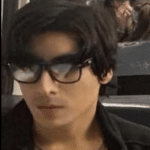
- I am physicist and electrical engineer. My knowledge in computer software and hardware stems for my years spent doing research in optics and photonics devices and running simulations through various programming languages. My goal was to work for the quantum computing research team at IBM but Im now working with Astrophysical Simulations through Python. Most of the science related posts are written by me, the rest have different authors but I edited the final versions to fit the site's format.
Latest entries
-
 Laptops2024.07.09Laptop Storage Type Guide (PCIe NVMe, SATA III, HDD, eMMC)
Laptops2024.07.09Laptop Storage Type Guide (PCIe NVMe, SATA III, HDD, eMMC)
-
 Laptops2024.07.02Laptop Storage Speed Comparison (PCie NVMe 5.0, 4.0, 3.0, SATA III)
Laptops2024.07.02Laptop Storage Speed Comparison (PCie NVMe 5.0, 4.0, 3.0, SATA III)
-
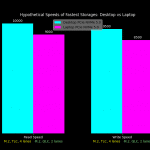 Hardware Guide2024.06.29Desktop Storage vs Laptop Storage Speed Performance Comparison
Hardware Guide2024.06.29Desktop Storage vs Laptop Storage Speed Performance Comparison
-
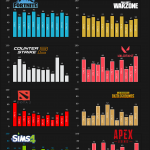 Hardware Guide2024.06.23Single-Thread vs Multi-thread CPU For Gaming (List & Benchmarks)
Hardware Guide2024.06.23Single-Thread vs Multi-thread CPU For Gaming (List & Benchmarks)
